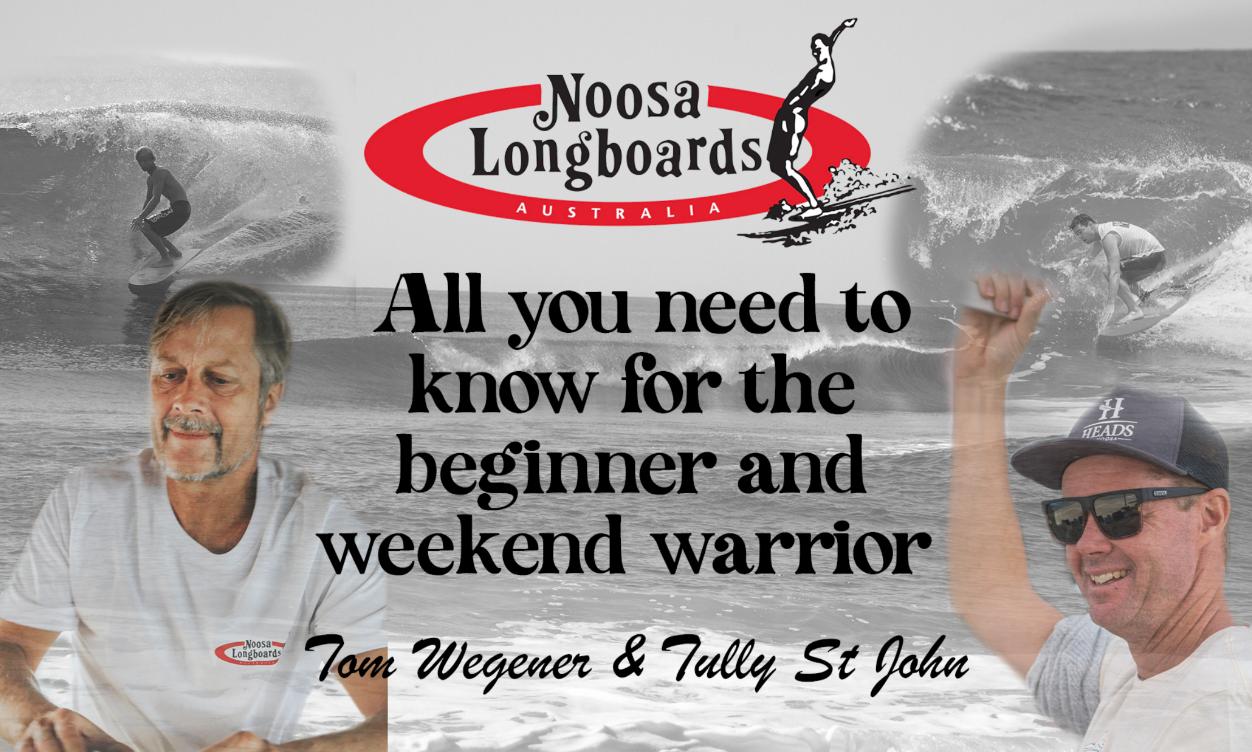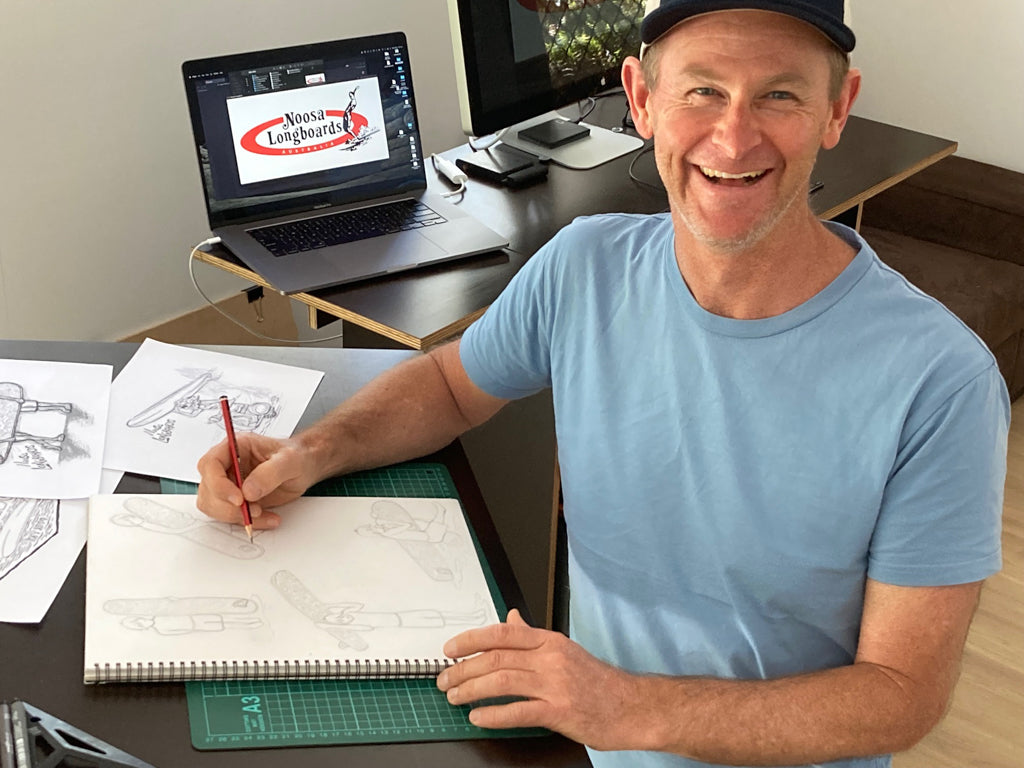Article: The Inside Scoop

The Inside Scoop
PhD Surf Culture- Noosa Longboards Designer Head Shaper/ Designer
Tom moved to Noosa over 20 years ago after a
stellar contest career in California as a team rider
at Takayama, pioneering longboard film maker
and board maker. He has been part of the NL
family for two decades and has won Surfer Magazine World Shaper of the year.
Tully is a second-generation board maker and part of
Noosa board making royalty. An accomplished short
and longboard rider and thirty years in the shaping
room- 75% of his life! He is the current Contest
Director for our iconic Noosa Festival of Surfing, what
he doesn’t know about surfing Noosa isn’t worth
knowing. It’s the ultimate partnership for us, quality drives every outcome.
Tom: If you stay within your comfort zone, small waves and easy conditions, the First Point is best. But, if you surf when you can and end up in less than ideal beach breaks, the Tea Tree is the board for you, the extra rocker and three fins are more suited for all around beach conditions.
Tully: The First Point and Little Cove models are designed for all riders, from beginner to pro. Both are easy and fast boards to paddle with heaps of glide and stability.
Q. I have seen this longboard revolution with girls in recent Years, would love to be a part of it, thinking it’s something my mum and I could both do, am 20 something, she is 40 something and young at heart. If we got a board each what style should we be looking for? Should the size and shape be a little different for females? ... And some tips on where to go to and what conditions until we get our confidence up?
Tom: If you are surfing with your mom your likely to search for easier, more predictable point or gentle sandbanks at the river mouth. The little cove would be best for mom. It is easy to control and you do not have to walk to turn it. For the son, the First point would be more stimulating with easier nose-riding options and stylish turns.
Tully: The Little Cove model is a great style for any rider. It’s easy to paddle and allows for a stable and controlled ride. The size and shape of the board depends on the rider. Boards can differ depending on your size, fitness and skill level. Noosa has many beginner friendly spots, including Little Cove and along the Noosa Spit. Mid-tide and smaller waves are ideal conditions for anyone to get their confidence up.
Q. Why buy a top end hand shaped board?
Tom: Talking to a shaper and getting a board made for you is the best option. There is a special connection of spirit from the artisan through the board to the rider. Understanding your board gives you a better sense of how to flow with the wave and feel the board interaction. It enhances the surfing experience.
Tully: A top end hand shaped board will last a lifetime. The quality materials used and the attention to detail creates a board that will perform better and last longer. Hand shaped boards can also be customised to the surfer and for the surf breaks.
Q. I reckon I have the basics pretty well covered. I surfed when I was a teenager with mates and getting back into it at 50, would love to be able to nose ride though, do you have some tips and what’s the easiest board to noseride on? You have a lot of different models?
Tom: For noseriding, the First Point is the best board for you. It is the most stable and trims through the white-wash well. This is important for setting up the noseride
Tully: The First Point model is designed with a wider nose and tail for longer and easier nose rides. The addition of a longer or wider fin provides additional hold and stability while hanging ten.
Q. Is it worth spending the extra money and maybe having more than one board? I am getting to the ocean more and more and i am not sure my single fin noserider first point model I got last year is working for me on beach breaks. I only go out when it below head height but it feels a bit awkward at time- I surf ‘okay’. Is it me or should I consider another board with more rocker or a midlength with three fins maybe? PS love my Tom Wegener belly board. It doesn’t matter what the surf is like, I never waste a drive from Brisbane!
Tom: To answer your question, you may want to try other boards off the hire rack at NL. Next time you come up and the surf is too big for the First Point, try another board like a Tea Tree or Boiling Pot. You will know right away if you want to go down that path.
Tully: It’s always a great idea to have more than one board for the different conditions and surf breaks. The Tee Tree and Boiling Pot models have more rocker and the option to have a box and side fins which will be easier to control and better suited for beach breaks.
Q. I hate asking about boards in store, I don’t know what they are talking about half the time. Planning on flying to Noosa next school holidays, help me out here guys! What difference does the rocker make on longboards?
Tom: Less rocker is harder to control when you are on the wave, but it paddles faster and is faster in small waves. More rocker is for bigger or less perfect waves because it is easier to turn and more stable.
Tully: More rocker on a board is suited for steeper waves and increased maneuverability. Less rocker will increase speed and allows faster paddling.
Q. What about concaves and double concaves, what’s the science with them?
Tom: Concaves create lift and quicken acceleration, when they are from the middle of the board to the tail. Double concave through the tail gives lift and speed through turns. When in the nose they give a little stability when noseriding.
Tully: Single concaves increase the water flow for speed and easy paddling. Double concaves also increase water flow but provides more turn and responsiveness.
Q. 50/ 50 rails/ 60/40 rails, what the hell does that stuff mean and how does it influence the type of board I should have as a weekend warrior?
Tom: 50/50 rails pull the board into the wave and the board is more nimble to slight adjustments. They are for small waves. Rails with an edge are meant to skate on top of water and are for bigger waves. They will skim out on to the shoulder for hard turns.
Tully: Surfboard rails influence the way the board performs in different conditions. 50/50 Rails provide more hold and stability and are better for noseriding. 60/40 Rails provide more release and turn-ability while also maintaining stability.
Q. If I have two different fins, can it really change the way my board surfs?
Tom: Having the right fin for the board is critical! The board and fin work together. A small change in fin or fin placement will change the feel of the board. If the board catches or does not follow your stream of consciousness, you probably need to move the fin or try a new one.
Tully: A fin with more flex and a narrower tip will give the longboard more turn-ability. A wider fin will give more hold for easy and controlled noserides. An all round longboard fin will turn and noseride.
Q. Okay, you try to get to the ocean two or three Saturdays a month surfing and maybe an annual trip to Noosa, you reckon you are an okay weekend warrior on your longboard, should you be going for a hipster noserider to look like the post hippie, crazy talented local crew on the points or an all rounder maybe? One or three fins?
Tully: An all rounder is great for those who surf a little less often and is versatile for different conditions. The Tee Tree model is the perfect all-rounder for surfing the points and the open beaches. It has more rocker for steeper waves, the box and side fin set-up allow for easier control, and there’s plenty of volume in the nose for hanging ten

